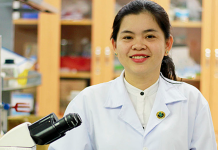
A university lecturer in Ho Chi Minh City has invented a gel for healing wounds and is about to test it on humans.
Nguyen Thi Hiep, 38, head of the biomedical engineering department at the International University, Vietnam National University, HCMC, has been researching since 2013 and successfully tested the gel on pigs.
A cross-linking gel based on chitosan, a type of sugar extracted from shell fish, and hyaluronic acid, the gel created by Hiep is for external use to stop bleeding and disinfect and heal wounds.
Hiep said when she and her team tested the product on pigs it prevented wounds from being infected and then quickly healed them without the need for sutures.
There is no need to remove the gel once applied on a wound, and it accelerates the regeneration of damaged tissues, she said.
Hiep said even people with no knowledge of first aid can apply the gel when someone is hurt before taking the victim to hospital, adding that the product would be particularly useful for people in remote areas far from medical facilities.
One advantage is the materials needed to make the gel are easily and cheaply available, she explained.
Chitosan can be extracted from the shell of crustaceans such as shrimp and crab, which are found plentily in Vietnam.
For her invention, Hiep was among four people to receive the 2018 L’Oréal-UNESCO for Women in Science International Rising Talent award in March last year.
Her biggest hurdle so far has been funding for the research.
She got VND2 billion ($86,000) from an American investment fund. But otherwise, during the six years of research and testing, she got some of her students to assist her and paid them herself.
“The gel needs testing on a larger scale and the attention of the government so that the product gets permission for commercial use,” she said.
“I really hope that benefactors, either individuals or organizations, will find this project interesting and useful and offer me financial aid so that I could complete it.”
She has sought funding from her university to study the gel’s anti-bacterial quality and ability to prevent scarring.
Hiep and her team are working to develop a version for injecting into knee joints besides using the gel to regenerate stem cells and tissues in cancer patients.
After graduating from the Ho Chi Minh City University of Science, Hiep received a master’s degree and PhD in biomaterials and tissue engineering at South Korea’s Soonchunhyang University.
She has been studying applied materials in medicine and how they work on cells and tissues for over 10 years.
In July she was one of two Vietnamese named in the list of 100 most outstanding Asian researchers of 2019 by Singapore’s Asian Scientist magazine.
Hiep was also honored with the 2017 ASEAN-U.S. Science Prize for Women for her research on homecare solutions to reduce the pressure on the public healthcare system.
By Cam Anh



